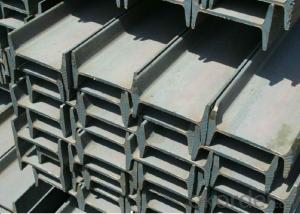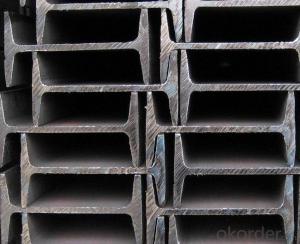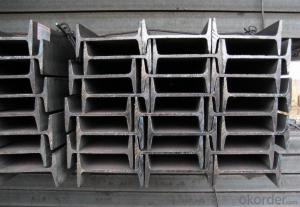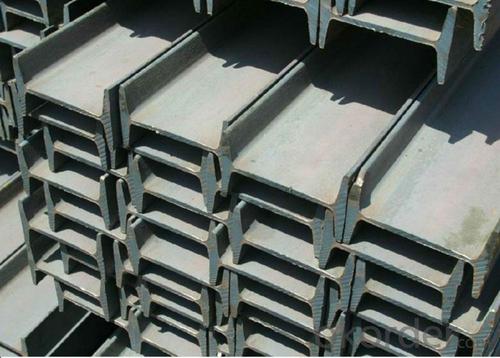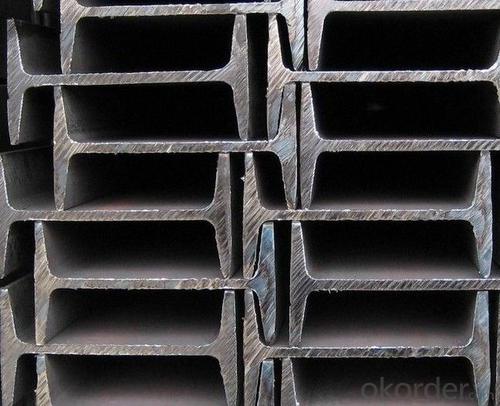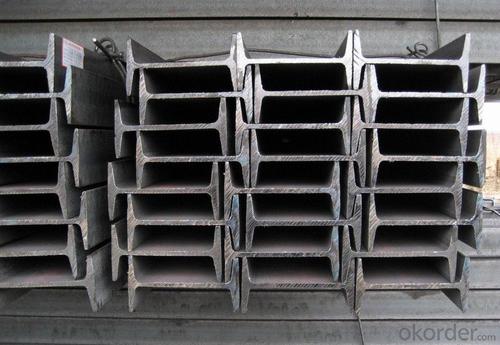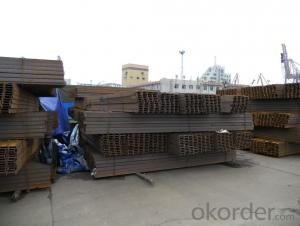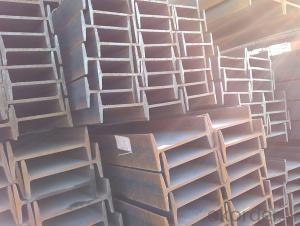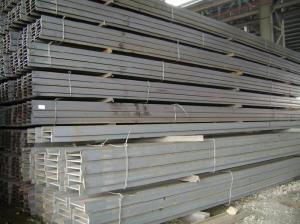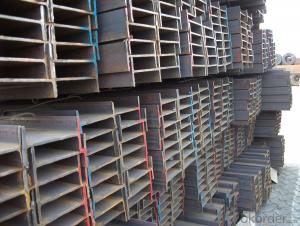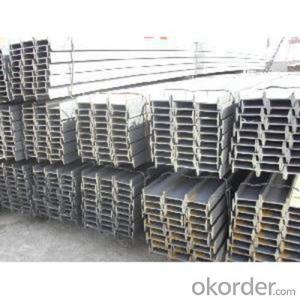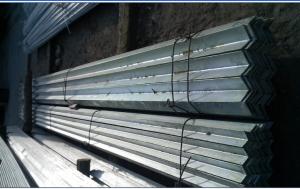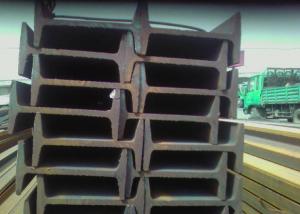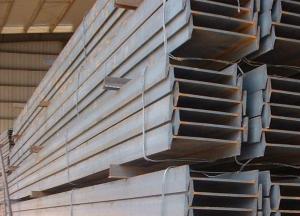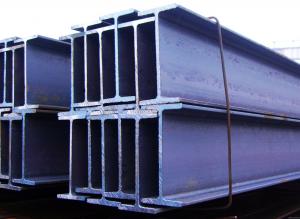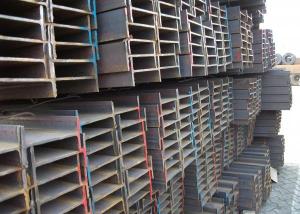IPE/IPEAA in European Standard with Competitive Price
- Loading Port:
- Tianjin
- Payment Terms:
- TT OR LC
- Min Order Qty:
- 25 m.t
- Supply Capability:
- 10000 m.t/month
OKorder Service Pledge
OKorder Financial Service
You Might Also Like
Product Description:
OKorder is offering high quality Hot Rolled Steel I-Beams at great prices with worldwide shipping. Our supplier is a world-class manufacturer of steel, with our products utilized the world over. OKorder annually supplies products to European, North American and Asian markets. We provide quotations within 24 hours of receiving an inquiry and guarantee competitive prices.
Product Applications:
1. Supporting members, most commonly in the house raising industry to strengthen timber bears under houses. Transmission line towers, etc
2. Prefabricated structure
3. Medium scale bridges
4. It is widely used in various building structures and engineering structures such as roof beams, bridges, transmission towers, hoisting machinery and transport machinery, ships, industrial furnaces, reaction tower, container frame and warehouse etc.
Product Advantages:
OKorder's Steel I-Beams are durable, strong, and resist corrosion.
Main Product Features:
· Premium quality
· Prompt delivery & seaworthy packing (30 days after receiving deposit)
· Corrosion resistance
· Can be recycled and reused
· Mill test certification
· Professional Service
· Competitive pricing
Product Specifications:
1. Invoicing on theoretical weight or actual weight as customer request
2. Standard: EN10025, GB Standard, ASTM
3. Grade: Q235B, Q345B, SS400, ASTM A36, S235JR, S275JR
4. Length: 5.8M, 6M, 9M, 12M as following table
5. Sizes: 80mm-270mm
Dimensions(mm) | |||||
h | b | s | t | Mass Kg/m | |
IPE80 | 80 | 46 | 3.80 | 5.20 | 6.00 |
IPE100 | 100 | 55 | 4.10 | 5.70 | 8.10 |
IPE120 | 120 | 64 | 4.80 | 6.30 | 10.40 |
IPE140 | 140 | 73 | 4.70 | 6.90 | 12.90 |
IPE160 | 160 | 82 | 5.00 | 7.40 | 15.80 |
IPE180 | 180 | 91 | 5.30 | 8.00 | 18.80 |
IPE200 | 200 | 100 | 5.60 | 8.50 | 22.40 |
IPE220 | 220 | 110 | 5.90 | 9.20 | 26.20 |
IPE240 | 240 | 120 | 6.20 | 9.80 | 30.70 |
IPE270 | 270 | 135 | 6.60 | 10.20 | 36.10 |
FAQ:
Q1: Why buy Materials & Equipment from OKorder.com?
A1: All products offered byOKorder.com are carefully selected from China's most reliable manufacturing enterprises. Through its ISO certifications, OKorder.com adheres to the highest standards and a commitment to supply chain safety and customer satisfaction.
Q2: How do we guarantee the quality of our products?
A2: We have established an advanced quality management system which conducts strict quality tests at every step, from raw materials to the final product. At the same time, we provide extensive follow-up service assurances as required.
Q3: The products are invoicing on theoritical weight or on actual weight?
A3: We can do it in both manners, according to the customers' request.
Images:
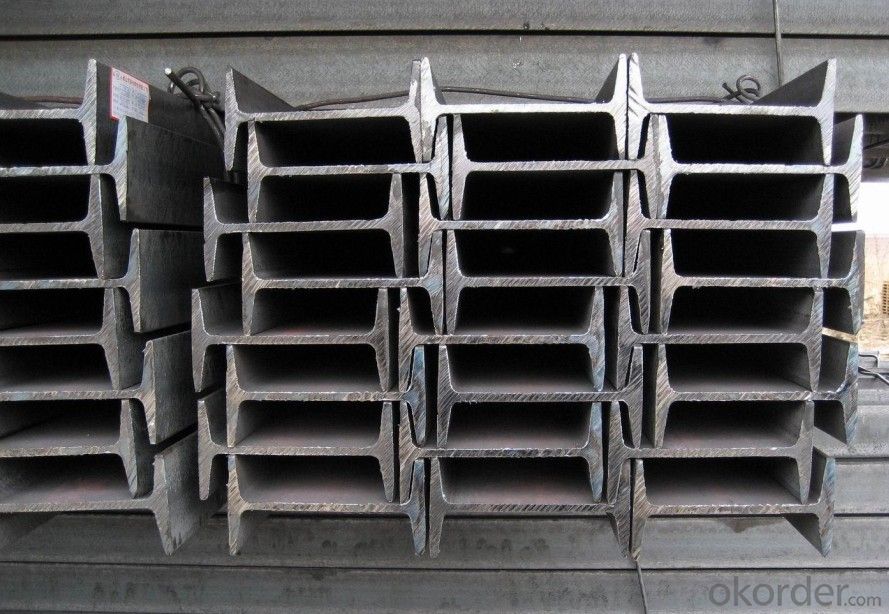

- Q: Can steel I-beams be used in seismic or high-wind areas?
- Yes, steel I-beams can be used in seismic or high-wind areas. Steel is known for its strength and durability, making it a suitable choice for structures in these challenging environments. I-beams, specifically, offer enhanced load-bearing capabilities and resistance to lateral forces, which are essential in seismic and high-wind areas. Additionally, steel structures can be designed to meet specific building codes and regulations to ensure their safety and stability in such conditions.
- Q: What are the common challenges in transporting and handling steel I-beams?
- There are several challenges involved in transporting and handling steel I-beams. One major challenge is the sheer size and weight of these beams, which can make maneuvering and transporting them safely difficult. To handle these heavy loads, specialized equipment such as cranes, forklifts, and trailers with appropriate weight-bearing capacities are necessary. Another challenge is ensuring that the I-beams are properly secured during transportation. If not secured correctly, the beams can shift or roll, resulting in damage to the beams themselves and potential accidents or injuries to personnel involved in the transportation process. To prevent any movement during transit, it is essential to use adequate strapping, padding, and bracing. The unique shape and design of I-beams also present challenges during handling. Stacking or storing them efficiently can be difficult, requiring special care to prevent damage or deformation. Handling I-beams manually can also be challenging due to their shape, often necessitating the use of specialized lifting equipment or machinery. Lastly, the length of I-beams can pose a challenge during transportation. Some beams can exceed the length of standard trailers or shipping containers, necessitating careful planning to ensure that the transportation method can accommodate their length. Oversized loads may require special permits or escorts, and routes must be chosen carefully to avoid any height or width restrictions. In summary, the challenges involved in transporting and handling steel I-beams include their large size and weight, the need for proper securing, the unique shape, and the potential length constraints. Overcoming these challenges requires the use of specialized equipment, careful planning, and adherence to safety protocols to ensure the safe and efficient transportation of steel I-beams.
- Q: How much load can a steel I-beam support?
- The load-bearing capacity of a steel I-beam relies on various factors, including the beam's dimensions, material composition, and support method. Steel I-beams are engineered for heavy loads and find common application in construction projects like bridges, buildings, and infrastructure. Engineers evaluate a steel I-beam's load capacity by considering its moment of inertia, section modulus, and yield strength. The moment of inertia measures the beam's resistance to bending, while the section modulus indicates its resistance to flexure. Yield strength signifies the maximum stress the beam can endure without permanent deformation. For a rough estimate, a typical residential steel I-beam serving as a structural support could potentially withstand a load ranging from a few hundred pounds to several thousand pounds. However, it is crucial to seek guidance from a structural engineer or qualified professional who can accurately calculate the load capacity based on the specific dimensions, properties, and intended usage of the I-beam. It is worth mentioning that the load capacity of a steel I-beam can be increased by adding more beams or increasing their size. Additionally, reinforcing the beam with supplementary materials like concrete or other composites can enhance its load-bearing ability. Ultimately, the load capacity of a steel I-beam relies on a combination of factors, necessitating a comprehensive analysis to provide an accurate answer based on the beam's specific parameters and intended application.
- Q: Elevator room in the cement blocks is what to do for?
- The cement block is used to install lift beam, installation height of lift beam elevation, to provide space for the installation of rollers, traction rope accessories, to ensure that the elevator to the top in the bottom and the top box when the elevator is parallel to the ground.
- Q: Can steel I-beams be used as columns or posts in construction?
- Indeed, steel I-beams have the potential to serve as columns or posts within construction projects. Their exceptional strength and capacity to bear heavy loads have made them extensively utilized in the construction industry. Employed as columns or posts, they effectively uphold substantial weights and ensure structural stability. Renowned for their resilience and resistance against bending or warping, steel I-beams prove themselves fitting for diverse construction endeavors. Moreover, they offer the convenience of customization to accommodate specific design specifications and can be manufactured in various dimensions and lengths.
- Q: Can steel I-beams be used for airport hangar construction?
- Airport hangars can indeed be constructed using steel I-beams. These I-beams are widely used in construction because of their robustness and durability. They offer structural support and can withstand substantial weights, making them ideal for constructing large span buildings like airport hangars. Moreover, steel I-beams can be effortlessly manufactured and tailored to meet the precise design specifications of an airport hangar. They also possess fire and corrosion resistance, which are crucial factors to consider in hangar construction. Hence, due to their dependability and aptitude to meet the distinctive requirements of such structures, steel I-beams are a favored choice for constructing airport hangars.
- Q: What is the cost of steel I-beams compared to other structural materials?
- The cost of steel I-beams is generally higher compared to other structural materials such as wood or concrete. However, steel I-beams offer superior strength, durability, and versatility, making them a preferred choice for many construction projects despite their higher cost.
- Q: What are the considerations for steel I-beam design in corrosive environments?
- When designing steel I-beams for corrosive environments, there are several important considerations to take into account. These considerations are crucial in order to ensure the longevity and safety of the structure. 1. Material Selection: Choosing the right type of steel is critical. Stainless steel, particularly grades such as 316 or duplex stainless steel, is often preferred due to its high corrosion resistance. These alloys contain additional elements like chromium and molybdenum that offer superior protection against corrosion compared to standard carbon steel. 2. Coatings and Surface Treatments: Applying appropriate coatings or surface treatments can further enhance the corrosion resistance of steel I-beams. Common options include hot-dip galvanizing, which involves immersing the steel in molten zinc, or epoxy coatings. These protective layers act as a barrier between the steel surface and corrosive agents. 3. Environmental Factors: Understanding the specific corrosive environment is crucial for steel I-beam design. Factors such as temperature, humidity, chemical exposure, and the presence of pollutants should be considered. For example, marine environments, where saltwater is present, can be particularly corrosive and require additional protection measures. 4. Maintenance and Inspection: Regular maintenance and inspection are essential to identify and address any signs of corrosion in steel I-beams. This includes monitoring the condition of coatings, promptly repairing any damaged areas, and ensuring proper drainage to prevent water accumulation. 5. Structural Design: The structural design of steel I-beams should consider the potential effects of corrosion. This may involve increasing the section dimensions to compensate for any anticipated loss of material due to corrosion. Additionally, designs should incorporate adequate ventilation to minimize moisture accumulation and promote drying. 6. Compatibility with Adjacent Materials: When designing steel I-beams for corrosive environments, it is important to consider the compatibility of the steel with other materials used in the structure. For example, the use of dissimilar metals in contact with steel can lead to galvanic corrosion. Proper insulation or the use of compatible materials can help prevent this type of corrosion. In conclusion, designing steel I-beams for corrosive environments requires careful consideration of material selection, coatings or surface treatments, environmental factors, maintenance, inspection, structural design, and compatibility with adjacent materials. By addressing these considerations, engineers can ensure the durability and integrity of steel I-beams in corrosive environments.
- Q: How do steel I-beams perform in terms of deflection and sagging?
- The excellent performance of steel I-beams in terms of deflection and sagging is widely recognized. This is due to their distinctive shape, which features a vertical web and horizontal flanges. As a result of this design, they have a remarkable resistance to bending and can support heavy loads without experiencing significant deflection or sagging. The distribution of load along the length of the beam is achieved through the design of I-beams. This design minimizes the amount of deflection that occurs. The vertical web contributes most of the beam's strength, while the horizontal flanges assist in resisting bending forces. This structural configuration ensures that I-beams can endure substantial weight and pressure without excessive bending or sagging. Furthermore, steel is an incredibly strong and durable material, making it an ideal choice for constructing I-beams. Its high tensile strength allows steel I-beams to handle heavy loads and resist deformation. This strength enables them to maintain their shape and prevent excessive deflection or sagging. Additionally, steel I-beams are frequently utilized in construction projects due to their high stiffness-to-weight ratio. This means that they are relatively lightweight in comparison to the weight they can support. The combination of their robust structural design and the inherent strength of steel allows I-beams to uphold their rigidity and prevent excessive deflection, even when subjected to significant loads. In conclusion, steel I-beams are highly effective when it comes to deflection and sagging. Their unique shape, along with the strength and durability of steel, allows them to support heavy loads and minimize any deformation or sagging that may occur. Consequently, they are a popular choice for various construction applications where maintaining structural integrity is crucial.
- Q: How do you calculate the maximum bending moment for a steel I-beam?
- To calculate the maximum bending moment for a steel I-beam, you need to consider the load applied to the beam and its span length. The bending moment is a measure of the internal force experienced by the beam when subjected to a load that creates a bending effect. First, determine the load applied to the beam. This could be a uniformly distributed load, a point load, or a combination of both. For example, if you have a uniformly distributed load of 10 kN/m over a span length of 5 meters, the total load would be 10 kN/m * 5 m = 50 kN. Next, calculate the reactions at the supports. These reactions will depend on the type of support and the load distribution. For example, if the beam is simply supported at both ends and subjected to a uniformly distributed load, each support would have a reaction of 25 kN. Once you have the reactions, you can determine the location and magnitude of the maximum bending moment. This occurs at the location where the shear force changes sign or reaches its maximum value. The bending moment at this point is calculated using the formula M = F * d, where M is the bending moment, F is the shear force, and d is the perpendicular distance from the point of interest to the point where the bending moment is being calculated. For example, if the shear force at the support is 25 kN, and the distance from the support to the point where the bending moment is being calculated is 2 meters, the maximum bending moment would be 25 kN * 2 m = 50 kNm. It is important to note that these calculations assume the beam is elastic and follows the linear elastic theory. If the beam is subjected to excessive loads, it may experience plastic deformation, which requires additional considerations and calculations. Additionally, the structural properties of the steel I-beam, such as its moment of inertia, cross-sectional dimensions, and material properties, also play a crucial role in determining the maximum bending moment.
Send your message to us
IPE/IPEAA in European Standard with Competitive Price
- Loading Port:
- Tianjin
- Payment Terms:
- TT OR LC
- Min Order Qty:
- 25 m.t
- Supply Capability:
- 10000 m.t/month
OKorder Service Pledge
OKorder Financial Service
Similar products
Hot products
Hot Searches
Related keywords
